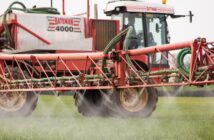The summer months are a critical time for black-grass control and while the main focus is on yield and crop quality Bayer is reminding growers to keep an eye on black-grass.
The vast majority of black-grass seed is shed prior to harvest, so field management decisions will have a big effect on the weed burden that you carry through to next season. The following tips will help farmers get the upper-hand on black-grass this summer.
Identify the problem
Harvest is a good time to identify any problem areas to deal with next season. Bad patches of black-grass are usually visible from the combine so make a note of areas or entire fields in need of special treatment. Yield maps can also be useful in spotting areas with soil issues and quite often compaction, poor establishment and black-grass come as a package which you can treat in one go.
Consider seed movement
Harvest operations move and disturb black-grass seed. Obviously, seed can be moved around farm on machinery so cleaning down tractors, trailers and combines is a must. After harvest, seed will be lying on the soil surface where it can be vulnerable to predation and the effects of UV light particularly if there is no protection from crop residues. If there is dry, sunny weather after harvest then consider delaying any cultivation to maximise this natural decline in black-grass.
Target deep cultivations
Empty fields are a great opportunity to manage the soil but only deep cultivate if necessary. Use maps and dig soil inspection pits to find where there is compaction and manage accordingly. Typically, headlands, gateways and local depressions suffer from compaction while the rest of the field may only need a lighter cultivation.
Be flexible
Don’t be a slave to a particular system or rotation. The aim is to control at least 95% of the black-grass in the field but there are number of ways to achieve this. Independent agronomist James Rimmer says: “I have seen a lot of growers becoming increasingly flexible in their cultivations using no-till when the weather is right but also looking at conventional methods when it is not.
“The main factor in black-grass control is attention to detail. The history of the field, the level of black-grass and soil type all need to be considered when developing a control strategy. As we all know there is no silver bullet to controlling black-grass, and although many farmers have the same problem, the solution can be totally different.”
Plough well
If seed return is high, consider turning to the plough as a reset button. Ploughing can see black-grass populations fall by 69% because seeds are pushed far below the soil surface where they are unable to germinate. However, in some cases ploughing can actually prolong black-grass problems.
Dr Stephen Moss has the following advice for those considering the plough: “Rotational ploughing is only really effective if you get a good inversion. A lot of farmers are failing to achieve the benefits because they’re ploughing in unsuitable conditions, going too fast or perhaps using the wrong type of plough so the seed isn’t being buried effectively.”
The recent long, dry spell will also make ploughing effectively difficult, so where it is being utilised it will pay to wait for moisture.
Prepare for your herbicide programme
Field conditions greatly affect the efficacy of residual herbicides. Cultivation decisions made now will have consequences when assessing weed levels next spring. To perform at their best, herbicides like Liberator (flufenacet + diflufenican) require a good, consolidated seedbed free of trash and clods so ensure that you use the time afforded by an early harvest to get seedbeds in good shape. As with ploughing, delaying for moisture will help growers, whatever the tillage method, with seedbed preparation.
When it comes time to apply pre-em herbicides Bayer’s Gordon Anderson Taylor advises growers to apply at the true pre-em timing within 48 hours of drilling to get the best result.
Adopt a long term approach
Remember that one good year of control does not mean your black-grass woes are over. Maintaining an integrated approach to black-grass over a prolonged period is the only way to ensure that grass weed populations stay at manageable levels on your farm.




